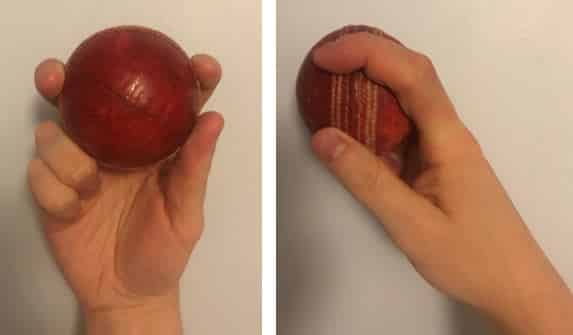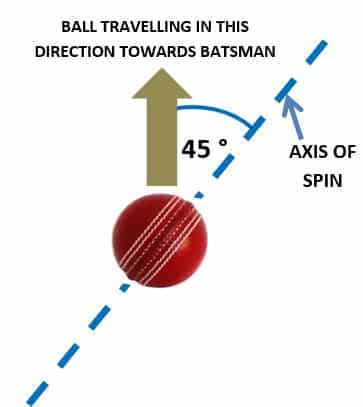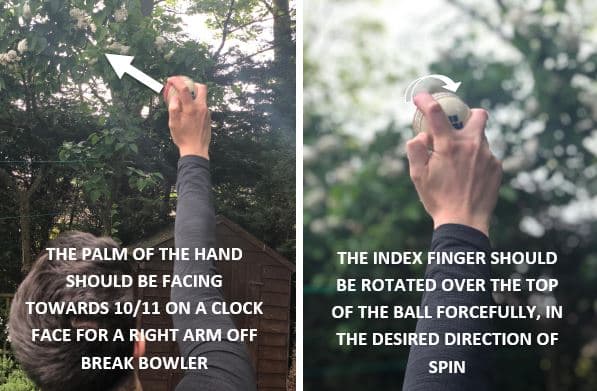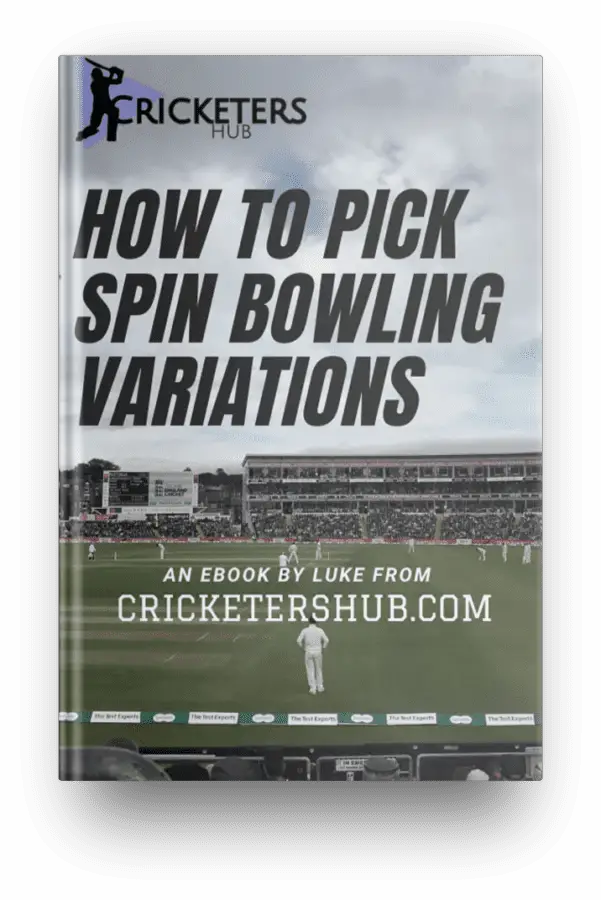Off break bowlers are the most common type of spinner that you will find in cricket. However, even though there are so many of them, it’s still difficult to find one that is capable of being a true match winner for their team! There aren’t many off break bowlers of this standard, and national cricket teams are always on the lookout for them! Consider this post as your first step on the journey to becoming that type of bowler!
If you’re not sure what off break bowlers are, then I’d probably start by reading this post where I explain all the different types of spinners you’ll encounter in cricket. It’s good to get these definitions nailed down before you head into a more detailed post like this one!
In this post I will teach you all the basics of off break bowling, so that any of you budding spinners out there know what you need to focus on! This post will follow a very similar theme to the guide I put together for bowling leg breaks, because off break bowling is challenging for a lot of the same reasons!
I think that in order to bowl the perfect off break delivery you should work on perfecting your technique in these areas:
- The Off Break Grip
- The Run-Up/Approach to the Crease
- How The Spin Is Applied To The Off Break
- Where To Pitch The Off Break
- The Speed Of The Deliveries
What Grip Is Used To Bowl The Off Break?
The grip used for the off break delivery is remarkably similar to the leg break grip. It requires you to place your index and middle fingers on the top of the ball, with the seam running horizontally across them. This is often referred to as the ‘two up, two down’ grip. For the off break, I like to spread the index and middle fingers a bit wider than I do when bowling leg breaks, as I feel like this helps me to get the maximum amount of spin on the ball. Graeme Swann is one of England’s great off break bowlers and I remember him saying the same thing. He would make sure the gap between his index and middle finger was very wide, and then try to use his index finger to spin the ball over the top of his middle finger. He said that this wider grip helped him to get the ball to spin more ferociously! The thumb does not need to be involved in the grip, but a lot of bowlers will choose to have it resting on the ball for extra support. The ring finger and the little finger are usually bent slightly and used to support the ball so it doesn’t fall from the hand. Have a look at the photos below to see the grip that off break bowlers should be using!

With all types of spin bowling, it’s important that the grip is relaxed enough for you to be able rotate your fingers smoothly over the top of the ball as it leaves your hand. When gripping the ball, make sure that it isn’t pressed firmly into the palm of your hand! You should leave a bit of a gap between the ball and the palm, as I tried to illustrate in the photos above!
If you’re a young cricketer and your hands aren’t big enough to hold the ball like I’ve just shown, then don’t worry! You won’t have to wait long until your hands have grown enough to hold the ball like that, but in the meantime, just focus on doing your best to get the ball to spin. Instead of having just the index and middle fingers on top of the ball, you could move your ring finger up there too and try to spin the ball with three fingers rather than 2. As you get older you can move to the proper grip!
What Is A Typical Run Up For Off Break Bowlers?
The run ups of all different types of spinners are relatively similar. An off break bowler should use their approach to the crease to build up a good amount of momentum. This momentum that we build during our run up is transferred into the ball as we release it, and therefore helps us to generate some of our pace! Some off break bowlers will prefer to have a very short and slow run up, and some will prefer to have a slightly longer, quicker one. It really all comes down to individual preference! However, there are a few main points that I think you should be aware of when you’re thinking about your run up and I’ll list those here:
- Most off break bowlers will have an approach to the crease which is around 5 – 10 paces in length.
- The approach to the crease will often begin at walking pace.
- The last 40% of the approach to the wicket will often involve the bowler quickening the pace of their steps. These faster steps allow the off break bowler to build that momentum that is vital for propelling the ball forwards at a good pace.
- I always recommend that you try to ensure that your movement towards the crease is as linear as possible. This isn’t as important for spinners as it is for fast bowlers, but I thought I would mention it regardless! Erratic sideways movement of the arms can subtract from your forwards momentum. Focus on the upcoming delivery as you go through your run up and try to limit any other extravagant movement.
How Is Spin Applied To The Off Break?
The most important part of the off break technique is how the spin is actually put on the ball! If you can get this part right early in your career, then everything else can be worked out and fine-tuned afterwards. Here are the basic steps:
- The bowler should stand at the end of their run up, then approach the wicket and begin their bowling action as usual.
- As the bowler is about to reach the crease, the ‘coil’ phase of the action begins. This is the part where the bowling arm comes up towards your head, before it begins its final rotation to deliver the ball. During the coil phase your wrist should be tilted back slightly towards your head. The wrist starting in this position allows us to extend it forwards more forcefully as the ball leaves our hand, allowing us to get more rotations on the ball.
- After the coil phase of the action, the bowling arm will rotate all the way around. The ball is released as the arm gets to its highest point.
- Spin is imparted on the ball as it leaves the hand. The wrist should be flicked forwards slightly at a 45 degree angle, allowing the index finger to rotate up the back of and over the top of the ball. It is this movement of the index finger that applies the spin to the ball. The movement of your hand as you spin the ball should be very similar to the way you would turn a doorknob. Thinking about this is often a good way to visualise what your hand needs to do during the process of bowling an off break!
Ideally, an off break delivery will spin at a 45-degree angle to the batsman. If you’re unsure what this means, then have a look at the diagram below!

The diagram shows an off break that is bowled by a right arm off break bowler. A left arm off break bowler (commonly referred to as a left arm orthodox bowler) would spin the ball at a 45-degree angle to the batsman in the other direction, with the seam pointing in a North-West direction.
A common error that you see a lot with off break bowlers is that they will either get too much top spin, or too much side spin on the ball. Getting too much top spin means that the ball will not spin laterally, instead it will often just bounce a little more and dip during its flight. Having too much side spin on the ball means that the ball may fail to grip the pitch at all, and instead of spinning in either direction will just skid on towards the batsman.
So how can you avoid these things? Basically, it all comes down to the position your bowling hand is in as you release the ball. To get the ball to spin at that perfect 45-degree angle, your hand must also be at that angle when you are bowling. This is a lot easier to explain if you imagine a clock face! If a right arm off break bowler has their palm pointing directly towards the batsman as they release the ball, then it would be pointing towards the number 12 on a clock face. Putting off spin on the ball with our hand in this position would lead to us getting a lot of side spin on the ball! Now imagine that same right arm off break bowler rotates their hand 90 degrees to the left. The palm of their hand will now be pointing towards the number 9 on a clock face, and if we spin the ball from this position we will only get top spin on the ball.
The desired direction for the palm of the hand to be facing for this bowler is in between those two points, between the number 10 and 11 on a clock face. Getting your hand in this position with the grip that I outlined earlier in this post will make sure that the seam is at the desired 45-degree angle to the batsman. All you have to do from this point is rotate the index finger forcefully over the top of the ball along that axis. This should spin the ball in the perfect direction. Left arm off break bowlers should be pointing their palm between the numbers 2 and 3 on the clock face as they deliver the ball.

If you’re unsure about your hand position, get a coach to watch you, or film yourself while you are bowling your off breaks. This is a good way to get a heads up on any technical issues that you are having. Once you are consistently getting your hand in the correct position, you can focus on learning to spin the ball more aggressively!
Where To Pitch The Off Break
All spinners are looking to achieve similar things, therefore the answer to where an off break should be pitched is roughly the same as where a leg break should be pitched! I like to boil this question down into a number of considerations, so here they are:
- The Batting Style – Your off breaks will be bowled in different areas depending on whether the batsman is right or left handed. A right arm off break bowler will be looking to pitch the ball outside a right handed batsman’s off stump to allow the ball to turn in towards them, but they may look to pitch the ball on the line of the stumps for a left handed batsman! Left arm off break bowlers would need to do the opposite. No matter where we look to bowl, I think it’s important to say that spinners should be trying not to bowl on the batsman’s legs too often. This can provide them with easy runs as they work the ball into the leg side and stops us building pressure through dot balls.
- The Shot We Want The Batsmen To Play – Spinners should always be trying to get the batsmen to come onto the front foot to drive the ball. When a batsman is playing the drive shot, it increases the number of wicket taking opportunities that we have. They could potentially get an outside edge to the slip fielders, an inside edge onto the pad that is caught by a close fielder, and they could also miss the ball entirely and get bowled through the gate! To get a batsman to drive, we must make sure we bowl the ball on a full length, just enough so that the ball would not bounce over the top of the stumps! You should also try and make sure that when the ball reaches them, it is on the off side of their body. This means you have to judge how much your delivery is likely to spin as you bowl it. If a right arm off break bowler pitches the ball a fraction outside a right hander’s off stump and the ball spins viciously, then the batsman will have an easy ball on the legs to work into the leg side. If we can manage to get the ball on the right length as well as the right line, then any misjudgement from the batsman could cost them their wicket!
- Weakness Of The Batsman – We should always be studying the habits of the opposing batsmen as we are bowling to them. If you see that they are struggling with a certain type of delivery, then you may be wise to bowl that delivery more often. If a batsman hits particularly well through the leg side but is weak through the off side, then you may wish to throw your deliveries a bit wider of the off stump. As you get more experience playing cricket, you will be able to spot these kinds of things a lot quicker. You can also try to expose issues with a batsman’s footwork! For example, if a batsman takes a large stride with his front foot over to the off side as you bowl the ball, then it may be a good idea to fire a quicker ball in at the pads. The quicker delivery may take them by surprise, meaning they cannot move their front leg and leaving them open to an LBW dismissal!
- Field Placings – As a bowler, you should always be conscious of where your fielders are and what your plan of attack is. Field placings are used to give us security, but they also allow us to attack batsmen in specific ways. If you have more fielders on the leg side then you may be more willing to bowl a bit closer to the pads. If you have more of an off side field, you can afford to bowl wider of the off stump and coax the batsman into an expansive drive. Work with your captain so that you can both understand what each other want to achieve. A common tactic is to leave the cover region free of fielders so that the batsman is more tempted to come forwards and drive the ball. As a bowler in this scenario there is always the risk that you could get hit for boundaries, but it means the batsman has to take risks too!
- Conditions Of The Pitch – Not every pitch is equal. Some of them will make our bowling more dangerous, and some of them will make it a lot easier for batsmen to deal with. If we notice that a pitch is bouncing more than usual, then we may choose to bowl a fuller length. This is because bowling our normal length on a bouncier pitch may lead to us bowling deliveries that are easy for the batsman to play on the back foot! We don’t want batsmen to be able to retreat into their crease to play our deliveries! Pitches that offer a great deal of spin may mean that we have to alter the line that we are looking to bowl. For example, if a right arm off break bowler is bowling on a pitch that offers an incredible amount of turn, it is probably best that they pitch the ball further outside the off stump than usual to allow for the extra spin! Off break bowlers will also alter their line and length based on how degraded a pitch becomes. In a 5 day test match, spin bowlers will specifically target rough areas on the pitch that are caused by bowlers’ footmarks. Bowling the ball into these drier areas can make it behave in strange ways, which can cause batsmen to play with uncertainty. An off break bowler should always be looking to use a worn pitch to their advantage!
What Speed Should The Off Break Be Bowled At?
Most professional off break bowlers will have an average speed somewhere in the range of 70-95kph (45-60mph). However, bowlers who haven’t reached adulthood yet may bowl slightly slower than this. For those of you that are still playing age group cricket, I wouldn’t worry too much about the pace of your off breaks just yet. That is something that you can really look to fine tune once you have nailed the rest of your spin bowling skills! Your first focus should be on getting the ball to spin as much and as consistently as possible…after all, this is your greatest weapon!
One piece of advice I will give for this is that you should never try to bowl too fast. Some off break bowlers who start getting hit for boundaries have a habit of firing the next few deliveries in like darts towards the batsman! Often, the opposite approach is the most effective. I remember Nathan Lyon (Australian Off Break Bowler) saying that after he had been hit for a boundary, he would come back for the next delivery and just try to bowl his best possible off break – focusing mainly on getting plenty of spin on the ball!
Once you have nailed the basics, you should also think about the flight on your deliveries. This basically refers to how high we get the ball during its flight! Often, this is the best way to confuse the batsman before the ball has even made contact with the pitch! You may choose to loop a series of consecutive deliveries higher and slower into the air, making sure that they travel above the batsman’s eyeline, before changing it up and bowling a quicker delivery on a flatter trajectory. This change in flight path can wreak havoc with a batsman’s foot placement and timing on their shots. This is definitely something that I would recommend experimenting with in the nets once you are confident in your accuracy and ability to spin the ball!
Other Commonly Asked Questions
How Do You Get An Off Break To Drift?
Some off break bowlers can get the ball to move laterally in the air before it pitches! This is similar to how fast bowlers get the ball to ‘swing’ but when a spinner does this, we call it drift! Off break bowlers aim to do this in order to beat the batsman during the flight of the ball. A delivery that drifts will ideally cause a batsman to misjudge their foot movement as well as their bat placement. There are a few main things that off break bowlers should focus on when looking to achieve drift, I’ll list them here:
- Getting Plenty Of Revolutions On The Ball – The more we spin the ball, the more likely it is to drift. It really is that simple! If we get the ball rotating forwards, towards the batsman, then we may get the ball to dip suddenly during its flight. If we get sideways rotations on the ball, it may move to the left or right in the air. An off break should be spinning in a direction halfway between forwards and sideways, therefore it is possible to get the ball to dip and drift laterally if we get plenty of spin on the ball!
- Flighting The Ball – If we toss the ball up a bit higher as we bowl, it will spend more time in the air before it reaches the batsman. This means that we are giving the air more time to have an effect on the delivery. Again, it really is that simple! Deliveries that aren’t flighted as much spend less time in the air, making them a bit less likely to drift.
- Environmental Conditions – Sometimes the wind can help us drift the ball. If there is a strong wind blowing across the ground from left to right or right to left, then off break bowlers can use this to their advantage.
Sadly, we cannot control what the weather is like when we’re bowling! However, we can control the amount of spin we get on the ball, as well as how much we toss the ball up. If you’re looking to practice getting the ball to drift then I’d focus on the first two things primarily!
How To Pick The Off Break
If you’re a batsman, sometimes it can be hard to tell whether an off break bowler is bowling a standard off break or if they’re bowling one of their other deliveries like an arm ball or a top spinner. If you’re someone that struggles with this, I recently combined all of my favourite tips and tricks for picking spinning deliveries into a 30-page Ebook – and now I’m giving it away for FREE! If you want to learn the same techniques that the professionals use, as well as what each delivery looks like as it leaves the bowler’s hand – I’d recommend heading over to giveaway.cricketershub.com, following the instructions and downloading your copy! It’ll definitely help you improve your game against spin.

Conclusion
Becoming an effective off break bowler can be difficult, but if you get the basics right early, you’ll find it much easier. The main things you should take away from this post are as follows:
- Having the proper grip is essential. This allows us to really rip the ball and get plenty of spin on it as we release it.
- Get your hand in the right place. Hand position during release is critical! It has the biggest influence on which direction we will spin the ball in.
- Spin is king! I really can’t say this enough, but the most important part of off break bowling is being able to spin the ball as much and as consistently as possible. This not only allows us to beat batsmen once the ball has hit the pitch, but also in its flight because it makes us more likely to get the ball to drift!
If you want to learn about other wicket taking methods that off break bowlers can develop, then you should read my piece covering all of the different spin bowling variations by clicking here! Aside from that, thank you for reading! I hope you have fun trying to take your spin bowling to the next level!
